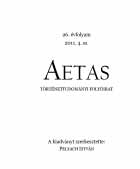Magyar–lengyel galíciai felkelési tervek és a kollektív emlékezet
Hungarian–Polish Galician Uprising Plans and Collective Memory
Author(s): Eva RingSubject(s): History
Published by: AETAS Könyv- és Lapkiadó Egyesület
Summary/Abstract: Following the First Partition of Poland, it was expected by both the Hungarian and the Polish nobility, who where traditionally on friendly terms with each other, that the recently acquired province of Galicia was to be part of the kingdom of Hungary. However, after long hesitation, Maria Theresa annexed Galicia to the hereditary lands. In 1772, Polish administration and jurisdiction were abolished in the new land, and the majority of officials were dismissed. The implementation of Austrian administration, German as the official language and the substitution of Polish functionaries with German and Czech officials shocked the Polish nobility. It was soon recognized that the Polish estates of Galicia would make a natural ally of the nobility in Upper Hungary, utterly dissatisfied with Hapsburg customs policies. Finished in October 1792, the French revolutionaries' foreign policy strategy for rearranging the existing balance of power in Europe entitled “Instructions and principles to be followed during the negotiations with the King of Prussia” did contain the name of Galicia. The draft presented in Paris in January 1973 by Thaddeus Kosciusko, the envoy of Polish immigrants living in Saxony was a response to this paper. According to the Polish proposition, the implementation of France’s plan should start with “instigating riots and local uprisings in Hungary, Galicia, Bohemia, Silesia, Prussia and Russia”. We know that, due to internal power struggles among French leaders, Kosciusko got no substantive response from foreign affairs minister Lebrun and returned to Saxony to learn that he had been elected as the leader of the uprising in preparation by the Warsaw conspirators. The Galician uprising could possibly be a part of their plans, given that Kosciusko himself went there in order to supervise the preparations in the autumn of 1793. He requested help from the French before the outburst of the uprising by sending Franciszek Barss to the Committee of Public Safety in Paris. The Galician movement was to have a preponderant role in his plans: “Especially Galicia, this province important to the House of Hapsburg could easily be annexed by Poland. The Galicians had already contacted the Commander-in-Chief in order to perform military operations together with the Polish.” On the basis of the reports of the Polish emigrants in Venice and the Austrian government's informers, we can be almost certain that, in addition to the Galician uprising plans, the idea of a Hungarian-Polish military cooperation had been raised. A substantial amount of circumstantial evidence shows that Austrian and Hungarian Jacobins had the intention of raising an army of 30,000 volunteers to support the Kosciusko Uprising.
Journal: AETAS - Történettudományi folyóirat
- Issue Year: 2011
- Issue No: 4
- Page Range: 15-34
- Page Count: 20
- Language: Hungarian

